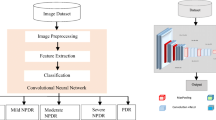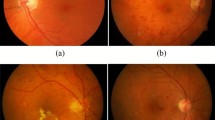Abstract
Glaucoma is an eye disease where a loss of vision occurs as a result of progressive optic nerve damage usually associates with high intraocular pressure. A subtype of glaucoma called primary angle-closure glaucoma (PACG) has been observed to be the result of one or more mechanisms such as Pupil block, Plateau iris, Peripheral iris roll, and Lens in the anterior segment of the eye. Reliable features in anterior segment images are important for determining the specific mechanisms involved in PACG. In this paper, first the discriminant features are selected by several feature selection algorithms in the context of PACG detection based on anterior segment optical coherence tomography (AS-OCT) images, and then a novel criteria is proposed to further select more reliable features. Our approach is based on selecting the top-ranked features in each algorithm and its rank combination for selection of the best features. Compared with the features selected by the individual feature selection methods, the features selected by our method achieves the best performance in terms of the accuracy of classification of the four PACG mechanisms by using AdaBoost classifier.






Similar content being viewed by others
References
Quigley, H. A., and Broman, A. T., “The number of people with glaucoma worldwide in 2010 and 2020”. Br. J. Ophthalmol. 90(3):262–267, 2006.
Lowe, R. F., “Aetiology of the anatomical basis for primary angle-closure glaucoma. Biometrical comparisons between normal eyes and eyes with primary angle-closure glaucoma”. Br. J. Ophthalmol. 54(3):161–169, 1970.
Acharya, U. R., Dua, S., Du, X., Sree, S. V., and Chua, C. K., “Automated diagnosis of glaucoma using texture and higher order spectra features”. IEEE Trans. Inf. Technol. Biomed. 15(3):449–455, 2011.
García G. S., Galilea E. H., “Using artificial neural networks to identify glaucoma stages,”. In: The Mystery of Glaucoma, Intech Publishers, 331–352, 2011.
Pachiyappan, A., Das, U. N., Murthy, T. V. S. P., and Tatavarti, R., “Automated diagnosis of diabetic retinopathy and glaucoma using Fundus and OCT images”. Lipids Health Dis. 11(73):1–10, 2012.
Mookiah, M. R. K., Acharya, U. R., Lim, C. M., Petznick, A., and Suri, J. S., “Data mining technique for automated diagnosis of glaucoma using higher order spectra and wavelet energy features”. Knowl.-Based Syst. 33:73–82, 2012.
Krishnan, M. M. R., “Automated glaucoma detection using hybrid feature extraction in retinal fundus images”. J. Mech. Med. Biol. 13(1):1–21, 2013.
Nayak, J., Acharya, U. R., Bhat, P. S., Shetty, N., and Lim, T.-C., “Automated diagnosis of glaucoma using digital fundus images”. J. Med. Syst. 33:337–346, 2009.
Tham, Y. C., Li, X., Wong, T. Y., Quigley, H. A., Aung, T., and Cheng, C. Y., “Global prevalence of glaucoma and projections of glaucoma burden through 2040: A systematic review and meta-analysis”. Ophthalmology 121(11):2081–2090, 2014.
How, A. C., Baskaran, M., Kumar, R. S., He, M., Foster, P. J., Lavanya, R., Wong, H. T., Chew, P. T. K., Friedman, D. S., and Aung, T., “Changes in anterior segment morphology after laser peripheral iridotomy: an anterior segment optical coherence tomography study”. Ophthalmology 119(7):1383–1387, 2012.
Shabana, N., Aquino, M. C., See, J., Tan, A. M., Nolan, W. P., Hitchings, R., Young, S. M., Loon, S. C., Sng, C. C., Wong, W., and Chew, P. T. K., “Quantitative evaluation of anterior chamber parameters using anterior segment optical coherence tomography in primary angle closure mechanisms”. Clin. Experiment. Ophthalmol. 40:792–801, 2012.
Coyne A, Shovlin J, “AS-OCT Technology: Analyzing the Anterior Segment”, Review of Optometry, 2012. [Online]. Available: http://www.revoptom.com/continuing_education/tabviewtest/lessonid/108148/.
Han, J.-H., Kang, J. U., and Song, C. G., “Polarization sensitive subcutaneous and muscular imaging based on common path optical coherence tomography using near infrared source”. J. Med. Syst. 35:521–526, 2011.
Acharya, U. R., Yun, W. L., Ng, E. Y., Yu, W., and Suri, J. S., “Imaging system of human eye: A review”. J. Med. Syst. 32(4):301–315, 2008.
Nongpiur, M. E., Ku, J. Y., and Aung, T., “Angle closure glaucoma: a mechanistic review”. Curr. Opin. Ophthalmol. 22(2):96–101, 2011.
Ng, W. T., and Morgan, W., “Mechanisms and treatment of primary angle closure: a review”. Clin. Experiment. Ophthalmol. 40(4):e218–e228, 2012.
Leung, K., Chan, W. M., Ko, C. Y., Chui, S. I., Woo, J., Tsang, M. K., and Tse, R. K., “Visualization of anterior chamber angle dynamics using optical coherence tomography”. Ophthalmology 112:980–984, 2005.
Sng, C. C., Aquino, M. C., Liao, J., Ang, M., Zheng, C., Loon, S. C., and Chew, P. T. K., “Pretreatment anterior segment imaging during acute primary angle closure: insights into angle closure mechanisms in the acute phase”. Ophthalmology 121(1):119–125, 2014.
Wirawan, A., Kwoh, C. K., Chew, P. T. K., Aquino, M. C. D., Seng, C. L., See, J., Zheng, C., and Lin, W., “Feature selection for computer-aided angle closure glaucoma mechanism detection”. J. Med. Imaging Health Informat. 2(4):438–444, 2012.
Saeys Y, Abeel T, Peer YV, “Robust feature selection using ensemble feature selection techniques”. In: Proc. 25th European Conference on Machine Learning and Knowledge Discovery in Databases, Part II, Springer-Verlag, Berlin, Heidelberg, 313–325, 2008.
Peng, H., Long, F., and Ding, C., “Feature selection based on mutual information criteria of max-dependency, max-relevance, and min-redundancy”. IEEE Trans. Pattern Anal. Mach. Intell. 27(8):1226–1238, 2005.
Şen B, Peker M, Çavuşoğlu A, Çelebi FV, “A comparative study on classification of sleep stage based on EEG signals using feature selection and classification algorithms”, J. Med. Syst. 38, no. 18, 2014. (DOI: 10.1007/s10916-014-0018-0).
He, X., Cai, D., and Niyogi, P., “Laplacian score for feature selection”, in Advances in Neural Information Processing System, vol. 17. MIT Press, Cambridge, 2005.
Liu H, Setiono R, “Chi2: Feature selection and discretization of numeric attributes”. In: Proc. 7th IEEE Int. Conf. Tools with Artificial Intelligence, 388–391, 1995.
Duda, R. O., Hart, P. E., and Stork, D. G., “Pattern classification”. Wiley, New York, 2001.
Zhao, Z., Morstatter, F., Sharma, S., Alelyani, S., Anand, A., and Liu, H., “Advancing feature selection research: ASU Feature selection repository”. TR-10-007, School of Computing, Informatics, and Decision Systems Engineering, Arizona State University, Tempe, 2007.
Cawley G, Talbot N, Girolami M, “Sparse multinomial logistic regression via Bayesian L1 regularisation”. In: Advances in Neural Information Processing Systems 19:209–216, 2007.
Li, Y. J., Hsu, D. F., and Chung, S. M., “Combination of multiple feature selection methods for text categorization by using combinatorial fusion analysis and rank-score characteristic”. Int. J. Artif. Intell. Tools 22(2):1350001–1350025, 2013.
Freund, Y., and Schapire, R. E., “A Decision-Theoretic generalization of on-line learning”. J. Comput. Syst. Sci. 55:119–139, 1997.
Yoo, I., Alafaireet, P., Marinov, M., Keila, P.-H., Gopidi, R., Chang, J.-F., and Hua, L., “Data mining in healthcare and biomedicine: A survey of the literature”. J. Med. Syst. 36(4):2431–2448, 2012.
Ozcift, A., and Gulten, A., “A robust multi-class feature selection strategy based on rotation forest ensemble algorithm for diagnosis of Erythemato-Squamous diseases”. J. Med. Syst. 36:941–949, 2012.
Acknowledgments
This work was supported by Ministry of Education (MoE) AcRF Tire 1 Funding, Singapore, under Grant M4010981.020 RG36/11.
Conflict of interest
There is no conflict of interest.
Author information
Authors and Affiliations
Corresponding author
Additional information
This article is part of the Topical Collection on Patient Facing Systems.
Rights and permissions
About this article
Cite this article
Niwas, S.I., Lin, W., Bai, X. et al. Reliable Feature Selection for Automated Angle Closure Glaucoma Mechanism Detection. J Med Syst 39, 21 (2015). https://doi.org/10.1007/s10916-015-0199-1
Received:
Accepted:
Published:
DOI: https://doi.org/10.1007/s10916-015-0199-1




